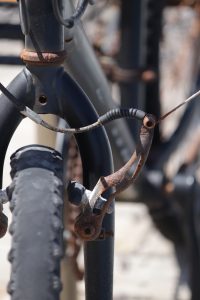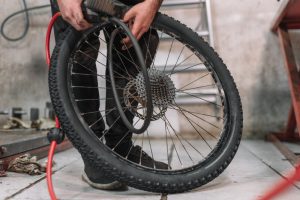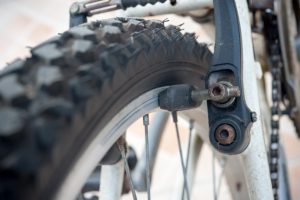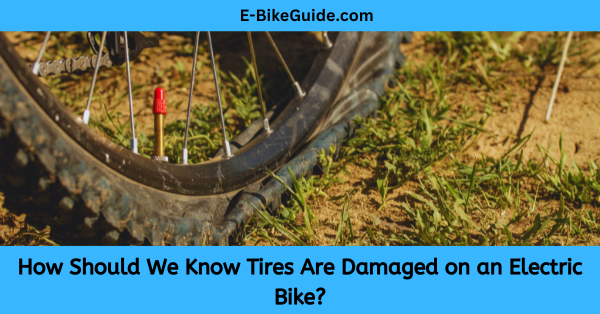Electric bikes, commonly known as e-bikes, have surged in popularity due to their convenience, efficiency, and environmental benefits. However, maintaining an e-bike involves paying close attention to several components, particularly the tires. Damaged tires not only reduce the performance of your e-bike but can also pose serious safety risks. This comprehensive guide will help you identify signs of tire damage on your electric bike and provide insights on how to address these issues.
Understanding the Importance of Tires on an Electric Bike

Why Tires Matter
Tires are the critical contact points between your e-bike and the ground. They influence your bike’s stability, handling, and overall ride quality. Properly maintained tires ensure a smoother ride, better grip, and increased safety.
Electric Bike Tire Construction
Electric bike tires are specially designed to withstand the additional weight and speed that e-bikes typically possess. They usually have reinforced sidewalls and are made from durable rubber compounds. Understanding the construction of your tires helps in identifying and diagnosing potential issues more effectively.
Signs of Damaged Tires

Visible Tread Wear
One of the most obvious signs of tire damage is visible tread wear. Tread patterns are essential for grip, especially in wet conditions. If the tread is significantly worn out, it’s time to replace the tire.
Checking Tread Depth
Use a tread depth gauge to measure the remaining tread on your tires. A tread depth of less than 1.6mm is considered dangerous and indicates that the tire needs replacement.
Cracks and Splits
Cracks and splits in the tire rubber are a clear indication of damage. These can occur due to aging, exposure to harsh elements, or overinflation.
Inspecting for Cracks
Regularly inspect your tires for any visible cracks on the sidewalls or tread. Small cracks can quickly develop into larger splits, compromising the tire’s integrity.
Bulges and Blisters
Bulges or blisters on the tire surface are signs of internal damage. These can result from hitting potholes or curbs and indicate that the tire structure is compromised.
Handling Bulges
If you notice any bulges or blisters, replace the tire immediately. Riding on a tire with these defects can lead to sudden blowouts.
Punctures and Embedded Objects
Punctures from nails, glass, or other sharp objects are common and can cause slow leaks or immediate flats.
Dealing with Punctures
Remove any embedded objects and assess the extent of the damage. Minor punctures can sometimes be repaired, but larger ones typically require tire replacement.
Performance Indicators of Damaged Tires

Decreased Traction
Damaged tires can significantly reduce your bike’s traction, making it harder to control, especially on wet or uneven surfaces.
Testing Traction
Perform a simple traction test by riding your bike on a controlled surface and checking for slippage. Reduced traction indicates the need for tire inspection.
Frequent Air Loss
Tires that require frequent inflation may have slow leaks or compromised integrity.
Monitoring Air Pressure
Regularly check your tire pressure with a reliable gauge. Consistent air loss necessitates a thorough inspection for leaks or other damages.
Vibrations and Unusual Noises
Unusual vibrations or noises during rides can be attributed to tire issues, such as uneven wear or internal damage.
Diagnosing Vibrations
If you experience unusual vibrations, inspect your tires for uneven wear patterns or deformities. Addressing these issues promptly can prevent further damage.
Preventive Maintenance for Electric Bike Tires

Regular Inspections
Regularly inspect your tires for any signs of wear or damage. Early detection can prevent more severe issues and ensure your safety.
Maintaining Proper Tire Pressure
Keeping your tires at the recommended pressure is crucial for optimal performance and longevity.
Using a Pressure Gauge
Always use a reliable pressure gauge to check your tire pressure. Refer to your e-bike’s manual for the recommended pressure range.
Avoiding Overloading
Excess weight can strain your tires, leading to premature wear and potential blowouts.
Understanding Load Limits
Check the manufacturer’s specifications for your e-bike’s load limits and avoid exceeding them. This practice will help maintain tire health and overall bike performance.
Safe Riding Practices
Adopting safe riding habits can significantly extend the life of your tires. Avoiding potholes, curbs, and rough terrains can prevent damage.
Adapting to Road Conditions
Be mindful of road conditions and adjust your riding style accordingly. Slow down on rough surfaces and avoid abrupt maneuvers that could strain your tires.
How to Repair Minor Tire Damages

Patching Small Punctures
For small punctures, you can use a tire repair kit to patch the hole. This is a temporary solution until you can replace the tire.
Using a Repair Kit
Follow the instructions provided in the repair kit carefully. Ensure the patch is securely placed to prevent further leaks.
Sealing Slow Leaks
Tire sealants can be used to temporarily seal slow leaks.
Applying Sealant
Inject the sealant through the valve stem, following the product instructions. Rotate the tire to evenly distribute the sealant.
Replacing Damaged Tires
For significant damage, replacing the tire is the safest option.
Choosing the Right Tire
Select a tire that matches your e-bike’s specifications. Consider factors like tire size, tread pattern, and durability.
Selecting Quality Replacement Tires

Understanding Tire Specifications
When selecting replacement tires, understanding the specifications is crucial for compatibility and performance.
Reading Tire Labels
Learn to read tire labels, which include information about size, load capacity, and pressure ratings. This knowledge ensures you choose the right tire for your e-bike.
Considering Tire Types
Different tire types offer varying benefits. Choose the one that best suits your riding style and terrain.
Types of E-Bike Tires
- Road Tires: Ideal for smooth surfaces, offering low rolling resistance.
- Off-road Tires: Designed for rough terrains, providing better grip and durability.
- Hybrid Tires: A balance between road and off-road tires, suitable for mixed terrains.
Evaluating Tire Brands
Opt for reputable tire brands known for their quality and reliability.
Popular E-Bike Tire Brands
- Schwalbe: Known for durability and performance.
- Continental: Offers a range of high-quality e-bike tires.
- Maxxis: Renowned for its off-road capabilities.
Steps to Replace an E-Bike Tire

Tools Required
Ensure you have the necessary tools before starting the replacement process.
Essential Tools
- Tire levers
- Wrench
- Pump
- New tire
Removing the Damaged Tire
Safely remove the damaged tire by following these steps.
Step-by-Step Removal
- Deflate the Tire: Completely deflate the tire to make removal easier.
- Loosen the Axle Nuts: Use a wrench to loosen the axle nuts or quick-release lever.
- Remove the Wheel: Carefully remove the wheel from the bike frame.
- Detach the Tire: Use tire levers to detach the tire from the rim.
Installing the New Tire
Install the new tire correctly to ensure optimal performance and safety.
Step-by-Step Installation
- Position the New Tire: Place one side of the tire onto the rim.
- Insert the Tube: If using a tube, slightly inflate it and place it inside the tire.
- Secure the Tire: Use tire levers to secure the other side of the tire onto the rim.
- Inflate the Tire: Inflate the tire to the recommended pressure.
- Reattach the Wheel: Place the wheel back onto the bike frame and tighten the axle nuts or quick-release lever.
Prolonging Tire Life

Regular Cleaning
Keeping your tires clean can prevent debris buildup and potential damage.
Cleaning Tips
Use a mild soap solution and a brush to clean your tires regularly. Avoid harsh chemicals that can degrade the rubber.
Proper Storage
Store your e-bike in a cool, dry place to protect the tires from environmental damage.
Storing Your E-Bike
Avoid prolonged exposure to direct sunlight and extreme temperatures. Store the bike with tires off the ground if possible.
Conclusion
Maintaining the tires on your electric bike is essential for ensuring safety, performance, and longevity. By regularly inspecting for signs of damage, adhering to proper maintenance practices, and promptly addressing issues, you can enjoy a smoother and safer riding experience. Always prioritize quality when selecting replacement tires and consider professional assistance if you’re unsure about the condition of your tires.
Frequently Asked Questions
1. How often should I inspect my e-bike tires?
We recommend inspecting your e-bike tires before every ride to catch any potential issues early and ensure a safe riding experience.
2. Can I repair a punctured e-bike tire myself?
Yes, minor punctures can be temporarily repaired using a tire repair kit. However, for larger punctures or recurring issues, it’s best to replace the tire.
3. What is the ideal tire pressure for e-bike tires?
The ideal tire pressure varies based on the tire type and manufacturer specifications. Refer to your e-bike’s manual or the tire sidewall for the recommended pressure range.
4. How can I increase the lifespan of my e-bike tires?
Regular inspections, maintaining proper tire pressure, safe riding practices, and proper storage can significantly increase the lifespan of your e-bike tires.
5. Are there specific tires recommended for different terrains?
Yes, road tires are best for smooth surfaces,
off-road tires for rough terrains, and hybrid tires for mixed terrains. Choose the type that best suits your typical riding conditions.
